I’m currently on my 5th week in Medellín, and it’s been quite an amazing experience so far! When I first arrived here, Medellin was just another city, but after a few weeks of learning and exploration, I’ve realized that this is a very special place with a fascinating history.
El Poblado
During my first week, I started off by visiting a castle and gardens in the luxurious El Poblado district, known as the commercial center of the city. It was once the house of the physician José Tobón Uribe until 1943 when industrialist Diego Echavarría Misas bought the house for his family. The inside of the castle contained beautiful antiques, paintings, and sculptures and there were panoramic views of the city from the windows. After my visit to the castle, I walked down a hill to the main square and explored the neighborhood. El Poblado was all very manicured—leafy boulevards, shiny malls, lavishly-decorated cafes and hotels. Though, I was told by locals that this did not represent the “real” Medellin—at least, not the city that the majority of the residents lived in.
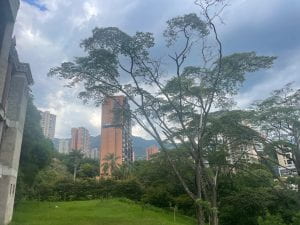
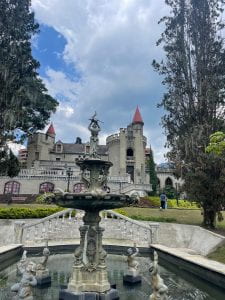
Comuna 13
I began to venture more outside of the wealthiest districts of the city. For instance, a couple of my fellow Rice students and I visited Comuna 13, a historically low-income, informal settlement that was originally occupied by rural migrants who had been displaced from their homes. The neighborhood’s residents were often caught in the crossfire between gangs, drug trafficking organizations, guerillas, and paramilitary groups. In the last 20 years, a government-sponsored re-development project and the construction of outdoor escalators has transformed the neighborhood into a safe tourist attraction with very little violence. Today, thousands of people visit Comuna 13 each day to view its colorful graffiti art, which was created by local artists as symbols of hope and resilience in the community. However, one could say that Comuna 13 is no longer the “real” Medellin either—as it is now overrun by souvenir shops and foreign visitors. There is also an argument to be made that the increasing tourism makes the residents of the neighborhood a spectacle—though it has also provided a large boon to the economy, promoting local businesses and the creation of jobs.
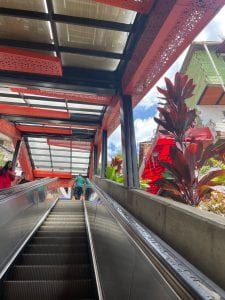
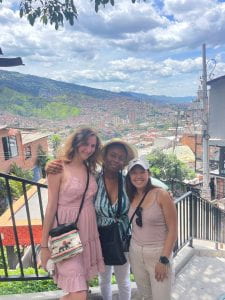
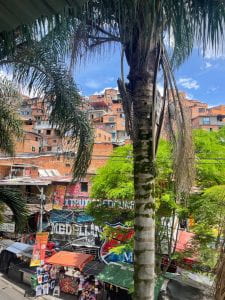
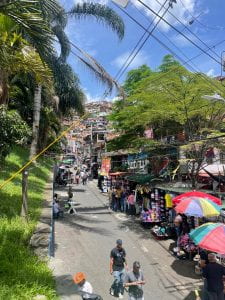
MetroCable
Another memorable experience I’ve had so far is riding the Medellin Metro Cable, a public transportation service and gondola lift system. It was designed to connect low-income communities on the city’s steep hills to the Valley of Aburra, which includes the city center. Before the invention of the Metro Cable, some hillside residents in communities such as Santo Domingo spent nearly 3 hours commuting to work because of the lack of a convenient bus system. When the service began its operations in 2004, the Metro Cable improved the mobility of residents of mountainside communities and massively shortened their commutes to work. Many studies attribute the gondolas to reductions in crime and an increase in economic prosperity in areas near the MetroCable.
There are also spectacular views from the gondolas. From the last stop at Santo Domingo, I was able to see large parts of the city and the Andes mountains in the distance. I also enjoyed being able to look down and see houses, streets, basketball courts, food vendors, and graffiti. It was like getting a little slice of life from a bird’s eye view.
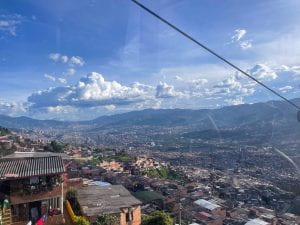
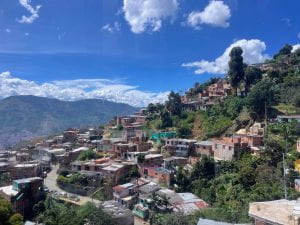
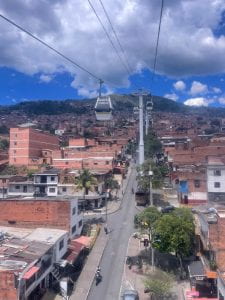
Bike Tour
A couple weeks ago, I decided to sign up for a 4-hour bike tour. It was a chaotic and strenuous ride—but, ultimately, it was incredibly rewarding. First, we biked up Cerro Nutibara, a steep hill in the middle of the city, that left me exhausted and out of breath. Luckily, there was a refreshing coconut drink once we got to the top.
One of my favorite parts of the tour was biking through Downtown, which was a surreal experience, since it was packed to the brim with people. Trying to bike through large crowds, motorcycles, cars, and street vendors was definitely a challenge, though it was a great way to experience the vibrance of the city center. We stopped right outside the main train station for a Colombian snack, and I got to eat this delicious arepa de chocolo, which is basically a fried corn tortilla with cheese on top.
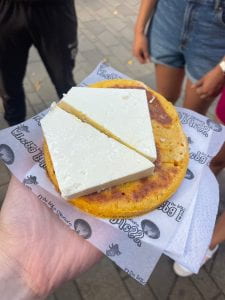
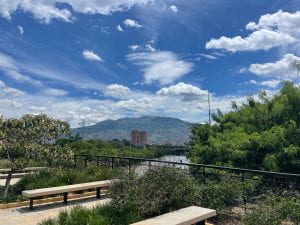
Throughout the tour, I learned a lot about Medellin’s status as one of the world’s most innovative cities that has set many milestones for sustainable design and equitable urban planning in the last 25 years. Recently, miles of cycling lanes were added to streets across the city, including in both low-income and high-income areas. Medellin has also introduced a new initiative called ciclovia, in which they close one of the major roads, Avenida Poblado, on Sundays and open the street up entirely to pedestrians, bikers, and even roller skaters.
Conclusion
It was interesting to see how perhaps Houston had much to learn from Medellin in terms of public transportation, infrastructure, and sustainable design. Medellin certainly still has a long way to go; in my experience, the bike infrastructure was not perfect—sometimes I was on the road with cars and a few times I had to swerve to avoid potholes—but I would say that it was still better than my biking experience in Houston.
Furthermore, while Medellin still has a significant amount of inequality, it was truly fascinating to see the transformation that the city has undergone only in the last couple decades. The MetroCable and the outdoor escalators, in particular, were some of the best examples of creative and equity-focused public transportation, and were both pretty incredible to witness in-person.

